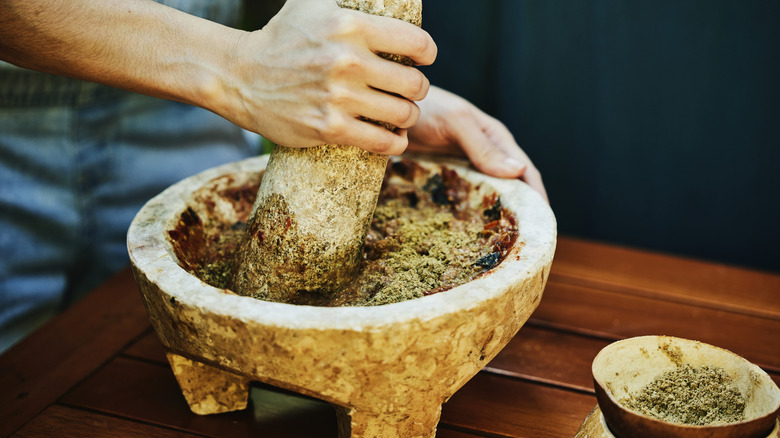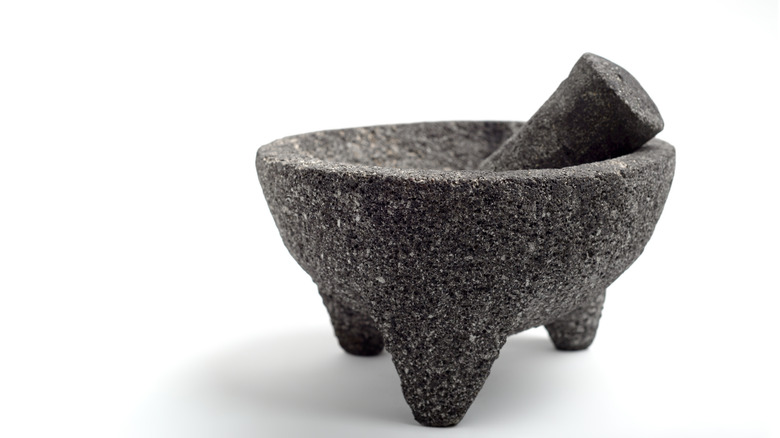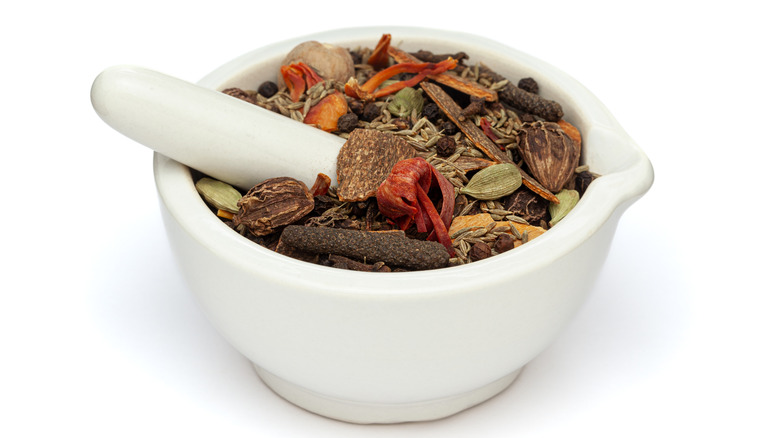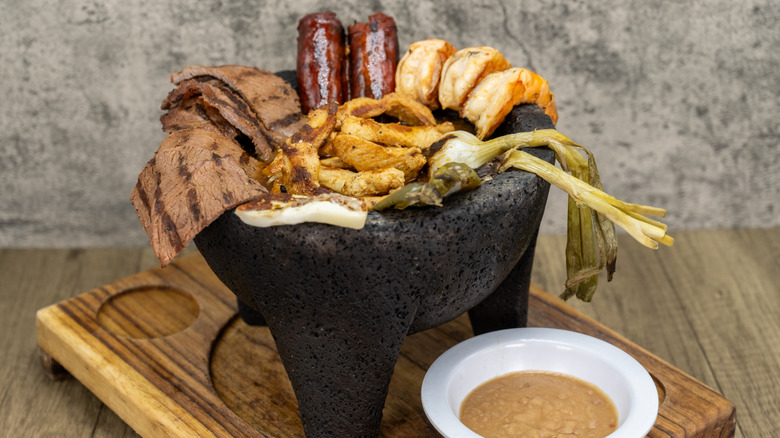Is A Molcajete The Same As A Mortar And Pestle?
Whether it's an uncommon kitchen gadget or a dependable culinary favorite, utensils cover a wide range of purposes. And while this era's electronically-guided tools have brought new techniques, there's a certain magic in old favorites. Few are more traditional than the mortar and pestle. Around for some 37,000 years, the tool is deeply rooted in interactions of humans and food.
Originally made to pulverize grains, the mortar and pestle is now employed for crafting spice mixes, pastes, and sauces, as well as processing raw ingredients. Found globally across Southeast Asia, the Americas, and the Middle East, the device is essential to many cuisines. Such is especially true in Central America and Mexico, where there's a specific storied type called the molcajete. This version of the mortar and pestle offers unique qualities in composition and shape.
The device is made from a special volcanic stone with a coarse, mineral consistency that contributes to a unique grind. The bowl shape can be wider than a mortar and pestle — when especially shallow, it's differentiated into a metate. Furthermore, the molcajete typically comes with three supporting legs, and sometimes has ornate decoration. As a result, the molcajete is different from other mortar and pestles.
What is a molcajete?
The molcajete has been utilized in Central America and Mexico for thousands of years. It's typically made from tough, porous volcanic rock, which lends it a distinct feel. In addition to imparting a coarseness that further pulverizes foods, the tool itself lends dishes a slight mineral flavor. Not to mention the fact that tiny fissures in molcajete accumulate aromas, further improving the flavor of your food over time. Analogous to seasoning a cast iron skillet, a new molcajete requires grinding grains prior to cooking in order to remove a stone debris coating.
The molcajete is predated by the metate, a flatter and wider version used to pulverize grains, especially corn. This version is still in use, but also evolved into the bowl-shaped molcajete. Typically supported by three legs, this vessel can feature decorative elements, and is commonly engraved with animals. In addition to being fundamental to several cuisines, molcajetes are regarded as cultural objects, too.
Most popularly, the device is used to create condiments like salsas, guacamole, and the similar guacamole substitute guacachile, as well as for grinding spices, peppers, and seeds for mole. The friction and heft release juices and alter textures, as well as express oils. Done manually, the molcajete allows for delicate control of texture, nailing consistencies to a tee.
What is a mortar and pestle?
Among the most ancient tools in the kitchen, the mortar and pestle is simple, but clever. It's formed of only two parts: the rounded mortar pestle bowl, and the rod-like pestle. Typically made of the same material, the aim of the device is to pound materials. Yet what initiated as a mode of crushing grains into edible forms turned into a far more versatile device. The mortar and pestle is extremely effective at grinding down foods, with its repetitive twisting motion drawing out food oils and thereby flavors. Extraction is so efficient, mortar and pestles are used in medicinal and industrial contexts, too.
The device comes in a range of sizes, with many models erring on the smaller side. The typical diameter of a mortar and pestle is approximately six inches. The tool can be composed of varying materials, from rocks like granite and marble to brass, porcelain, and even wood. Textures can range from rough (like the molcajete) to polished smooth. Such varied compositions and sizes reflect the many uses of the mortar and pestle.
A classic use for a mortar and pestle is the pulverization of spices, with many models reserved exclusively for grinding spices. Whether it's powdering saffron without fear of flavor interference or crafting aromatic spice blends, the vessel mingles spice notes and creates freshly ground seasonings. Alternatively, it can also be used for crushing juicer ingredients like garlic, as well as assembling condiments, sauces, and marinades.
The molcajete is a specific type of mortar and pestle
Molcajetes are a subtype of mortar and pestle; unsurprisingly, there's a lot of overlap in appearance and function. Nevertheless, the two devices do offer distinctions. For one, there's the volcanic composition of the molcajete, which has a porous texture that's not well-predisposed for things like pulverizing garlic, but shines in releasing aromatics. The tiny holes of the molcajete can become clogged, so Mexican cooks delineate two molcajetes for respective wet and dry uses.
Plus, the two devices pack in physical distinctions, too. In addition to the leg-like supports of the molcajete, the vessel is typically larger in size. Models can exceed 15 inches in diameter, packing in over two gallons of foodstuff. Such a characteristic grants the molcajete abilities that aren't possible with a mortar and pestle (which is often over twice as small). The larger vessel can grind whole peppers, onions, garlic, and tomatoes simultaneously, assembling condiments all in one go. Meanwhile, the mortar and pestle typically processes ingredients that will later be combined into a dish.
With the molcajete's large capacity, you'll even find foods served in the vessel — a move unimaginable with a mortar and pestle. A Mexican creation known as molcajete mixtos, these types of dishes contain proteins, salsas, beans, vegetables, and more, all served in the molcajete. Aromatics are first pulverized in the vessel, lending extra infused flavor to the final dish, and the molcajete is heated up to produce a mouth-watering presentation. Such qualities show that both tools offer their own advantages, so consider buying a model of each to enhance your cooking.



